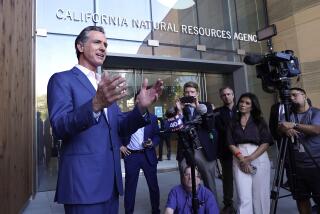Let’s close the information gap about fracking
As a public policy, denial requires one prerequisite to take root: lack of information. So it’s proper to ask whose interests the California Senate was protecting last month when it killed a measure requiring oil drillers to give public notice before fracking.
Fracking — “hydraulic fracturing,” technically speaking — involves drilling a pipe horizontally into an underground oil- or natural gas-bearing formation and pumping a slurry into the formation at high pressure to liberate the hydrocarbons trapped within. It’s become increasingly popular as a way to tap oil and gas reserves that were once considered too costly to extract.
FOR THE RECORD:
Fracking: A column in the June 10 Business section that called on the oil and natural gas industry to release more information about fracking misidentified the federal Safe Drinking Water Act as the Clean Drinking Water Act.
Fracking has a lot of friends these days. There’s the oil and natural gas industry, which spends more than $4 million a year lobbying in Sacramento. And there’s Halliburton Co., which pioneered the technique in the 1940s and remains a huge player in the field. The company’s former CEO, ex-Vice President Dick Cheney, got Congress in 2005 to exempt fracking from regulation under the Clean Drinking Water Act, and it employs one of the best-connected lobbying firms in the state.
The slain bill, introduced by state Sen. Fran Pavley (D-Agoura Hills), would have done nothing to actually regulate fracking. It merely would have required that drillers notify local property owners and water authorities in advance that fracking was going to take place, and that groundwater be tested before and after the drilling so that any damage produced by the drilling could be pinpointed. The idea, Pavley says, is that “if there’s nothing to worry about, let’s go through a thoughtful monitoring and reporting approach to address the concerns the public has.”
Nevertheless, whether out of ignorance or misplaced solicitude for a well-financed industry, the state Senate killed the bill in a bipartisan 18-17 vote. Another bill, much watered down, remains on life support in the Assembly.
Fracking has become especially prevalent in natural gas-producing regions in Pennsylvania, Ohio and New York. For a time it even had the blessing of environmentalists, who reasoned that for energy generation gas is cleaner than coal and anything that encourages the production of the former over the latter must be good.
That view has been changed by evidence that the huge volumes of chemical-laden water used in fracking can contaminate local water tables and streams and bring unexpectedly high levels of radioactivity to the surface. Residents near fracking sites have reported that chemicals have rendered their water unusable and that gas has migrated into their mains, a phenomenon memorably depicted in the documentary “Gasland” when the water flow from a household tap is made to burst into flame.
In California, fracking has been used since the 1960s in drilling for oil, not natural gas, but the basic technique is the same. It’s getting much more attention today not only because of the problems that have emerged back East, but because the oil company Venoco has proposed fracking into the Monterey Shale, a vast petroleum reservoir that, if fully exploited, supposedly could double California’s known oil reserves.
This new interest in fracking plainly caught California regulators off guard. In January 2011, Pavley wrote to the state division of oil, gas and geothermal resources, or DOGGR (pronounced “dogger”), asking for information about the number and location of fracked wells in the state, the amount of water employed, the permitting process and what was known about the risk to groundwater.
The agency responded with a detailed four-page letter, the gist of which was: “We don’t know nothin’.” Its actual words were: “The Division is unable to identify where and how often hydraulic fracturing occurs within the state.” It also said that “the Division has not yet developed regulations to address this activity.”
“No one seems to know where the wells were and there’s no testing and no one knows what chemicals are being used,” Pavley observes. “It had been a self-regulated thing.”
Oh, right. Self-regulation. If you’d like a sample of how well that works in principle, consider that Wall Street was largely “self-regulated” before it created the crash of 2008.
The industry and DOGGR insist that much has changed in recent months. “There’s a lot of history since that letter,” says DOGGR’s chief deputy director, Jason Marshall, observing that the agency has acquired a new director, Tim Kustic, and a new view of the world.
“We know a little bit more about what we don’t know,” he told me. “We don’t know by our own reporting how many wells were actually fractured. We do have some numbers on that that we’ve gotten from the industry.” That sounds as though there isn’t all that much history since the letter.
The industry numbers come from voluntary submissions from fracking companies to the industry website Fracfocus.org. But it’s only fair to say that, objectively speaking, the website is worthless. It’s voluntary, so no one can tell whether it’s complete or reliable, and there’s no penalty for withholding information. Companies responsible for only 80% of production in California participate.
Late last week, the website listed 137 fracked wells in California; but DOGGR says it’s aware that 628 wells were fracked statewide in 2011, which gives you an idea of the potential information gulf. DOGGR has asked all operators to voluntarily report to Fracfocus, but the information isn’t submitted until after a well is completed, making it a teensy bit difficult for the regulators to be proactive.
Marshall says the division is now focused on efforts to “increase our knowledge about where is fracking happening and making sure it’s happening in a way that protects public health, safety and the environment.” He also observes that existing regulations already require wells to be “constructed safely, operated safely and maintained safely” regardless of the technology employed. “But we know that we don’t know when a well gets fractured, and we know that we should.”
As part of its rule-making process, DOGGR has been holding informational workshops for communities around the state, including two set for this week in Culver City and Long Beach.
The industry opposed Pavley’s bill because “it was nothing more than another attempt to make it harder and more costly to produce energy in California,” says Tupper Hull, spokesman for the Western States Petroleum Assn., the industry lobbying arm. “The scope of the reporting was overly broad, it didn’t make a lot of sense, and in our view there was nothing to suggest there was a public benefit from those notifications.”
Translation: The industry’s concern was that the more local residents and authorities knew about the drillers’ plans, the more opportunity they’d have to push back.
The demise of Pavley’s bill leaves a measure introduced by Assemblyman Bob Wieckowski (D-Fremont) as the subject of talks involving industry, environmental groups and other parties. But that bill has been getting steadily emasculated. The biggest sticking point involves trade secrets — that is, the exact formulation of the fluids injected into the ground during fracking. The industry wants to withhold these secrets even from regulators. That’s a “non-starter” for the Environmental Working Group, which sponsored both original fracking measures.
The industry’s preferred language would require well operators to file a form claiming a trade secret, without fully describing the secret to regulators. A given chemical, for example, could be identified merely by reference to its “chemical family or similar descriptor.” That could render the identification uninformative if not downright misleading — after all, it’s not unusual for a single chemical family to comprise medicines as well as poisons.
“The oil and gas industry wants to determine what is a trade secret and not even give the agency the names of the chemicals they consider secret,” says Renee Sharp, the environmental group’s California director. “So if you had some contamination later on, it would be very hard to trace it to fracking. You wouldn’t even know what chemicals to look for, and that is a real problem.”
Kustic and Marshall of DOGGR say that California will almost certainly get fracking-specific regulations, but that the rule-making process won’t be completed this year. That’s good, but thanks to the industry favoritism of our elected legislators, at least until that point we’ll be flying blind.
Michael Hiltzik’s column appears Sundays and Wednesdays. Reach him at mhiltzik@latimes.com, read past columns at latimes.com/hiltzik, check out facebook.com/hiltzik and follow @latimeshiltzik on Twitter.
More to Read
Inside the business of entertainment
The Wide Shot brings you news, analysis and insights on everything from streaming wars to production — and what it all means for the future.
You may occasionally receive promotional content from the Los Angeles Times.










